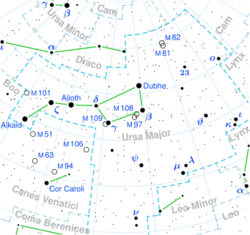Astronomy:Phi Ursae Majoris
| Observation data Equinox J2000.0]] (ICRS) | |
|---|---|
| Constellation | Ursa Major |
| Right ascension | 09h 52m 06.35437s[1] |
| Declination | +54° 03′ 51.5962″[1] |
| Apparent magnitude (V) | +4.60[2] (5.28 + 5.39)[3] |
| Characteristics | |
| Spectral type | A3 IV + A3 IV[4] |
| U−B color index | +0.08[2] |
| B−V color index | +0.03[2] |
| Astrometry | |
| Radial velocity (Rv) | −14.7±0.3[5] km/s |
| Proper motion (μ) | RA: −6.00[1] mas/yr Dec.: +19.16[1] mas/yr |
| Parallax (π) | 6.41 ± 0.59[1] mas |
| Distance | 510 ± 50 ly (160 ± 10 pc) |
| Absolute magnitude (MV) | −1.39[6] |
| Orbit[7] | |
| Period (P) | 104.6 yr |
| Semi-major axis (a) | 0.329″ |
| Eccentricity (e) | 0.436 |
| Inclination (i) | 19.4° |
| Longitude of the node (Ω) | 132.5° |
| Periastron epoch (T) | 1987.52 |
| Argument of periastron (ω) (secondary) | 33.3° |
| Details | |
| A | |
| Mass | 3.5±0.2[8] M☉ |
| Luminosity | 347[8] L☉ |
| Surface gravity (log g) | 3.69±0.16[9] cgs |
| Temperature | 8,769±150[9] K |
| Metallicity [Fe/H] | −0.23±0.08[9] dex |
| Rotational velocity (v sin i) | 28[8] km/s |
| Other designations | |
| Database references | |
| SIMBAD | data |
Phi Ursae Majoris, Latinized from φ Ursae Majoris, is binary star[11] system in the northern constellation of Ursa Major. It is white-hued and is visible to the naked eye with a combined apparent visual magnitude of +4.60;[2] the primary is magnitude 5.28 while the secondary is magnitude 5.39.[11] The system is located at a distance of approximately 510 light-years (160 parsecs) from the Sun based on parallax,[1] but is drifting closer with a radial velocity of −14.7 km/s.[5] It should make its closest approach at a distance of around 370 light-years in about 4.7 million years.[6]
As of 2017, the components had an angular separation of 0.50″ along a position angle of 304°.[3] They are orbiting each other with a period of 105.4 years and eccentricity of 0.44.[7] Both of components are A-type subgiant stars[12] with a stellar classification of A3 IV.[4]
Phi Ursae Majoris is moving through the galaxy at a speed of 21.6 km/s relative to the Sun. Its projected galactic orbit carries it between 24,000 and 46,000 light-years from the center of the galaxy.[6]
Naming
With τ, h, υ, θ, e, and f, it composed the Arabic asterism Sarīr Banāt al-Na'sh, the Throne of the daughters of Na'sh, and Al-Haud, the Pond.[13] According to the catalogue of stars in the Technical Memorandum 33-507 - A Reduced Star Catalog Containing 537 Named Stars, Al-Haud were the title for seven stars: f as Alhaud I, τ as Alhaud II, e as Alhaud III, h as Alhaud IV, θ as Alhaud V, υ as Alhaud VI and this star (φ) as Alhaud VII.[14]
In Chinese, 文昌 (Wén Chāng), meaning Administrative Center, refers to an asterism consisting of φ Ursae Majoris, υ Ursae Majoris, θ Ursae Majoris, 15 Ursae Majoris and 18 Ursae Majoris. Consequently, the Chinese name for φ Ursae Majoris itself is known as 文昌三 (Wén Chāng sān, English: the Third Star of Administrative Center).[15]
References
- ↑ Jump up to: 1.0 1.1 1.2 1.3 1.4 1.5 van Leeuwen, F. (2007). "Validation of the new Hipparcos reduction". Astronomy and Astrophysics 474 (2): 653–664. doi:10.1051/0004-6361:20078357. Bibcode: 2007A&A...474..653V. http://www.aanda.org/index.php?option=com_article&access=bibcode&Itemid=129&bibcode=2007A%2526A...474..653VFUL.
- ↑ Jump up to: 2.0 2.1 2.2 2.3 Johnson, H. L. (1966), "UBVRIJKL Photometry of the Bright Stars", Communications of the Lunar and Planetary Laboratory 4: 99, Bibcode: 1966CoLPL...4...99J.
- ↑ Jump up to: 3.0 3.1 Mason, B. D. et al. (2014), "The Washington Visual Double Star Catalog", The Astronomical Journal 122 (6): 3466, doi:10.1086/323920, Bibcode: 2001AJ....122.3466M, http://vizier.u-strasbg.fr/viz-bin/VizieR?-source=B/wds, retrieved 2015-07-22
- ↑ Jump up to: 4.0 4.1 Edwards, T. W. (April 1976), "MK classification for visual binary components", Astronomical Journal 81: 245–249, doi:10.1086/111879, Bibcode: 1976AJ.....81..245E.
- ↑ Jump up to: 5.0 5.1 Gontcharov, G. A. (2006), "Pulkovo Compilation of Radial Velocities for 35 495 Hipparcos stars in a common system", Astronomy Letters 32 (11): 759–771, doi:10.1134/S1063773706110065, Bibcode: 2006AstL...32..759G.
- ↑ Jump up to: 6.0 6.1 6.2 Anderson, E.; Francis, Ch. (2012), "XHIP: An extended hipparcos compilation", Astronomy Letters 38 (5): 331, doi:10.1134/S1063773712050015, Bibcode: 2012AstL...38..331A.
- ↑ Jump up to: 7.0 7.1 Hartkopf, W. I. et al. (June 30, 2006), Sixth Catalog of Orbits of Visual Binary Stars, United States Naval Observatory, https://www.usno.navy.mil/USNO/astrometry/optical-IR-prod/wds/orb6/sixth-catalog-of-orbits-of-visual-binary-stars, retrieved 2017-06-02.
- ↑ Jump up to: 8.0 8.1 8.2 Zorec, J.; Royer, F. (January 2012), "Rotational velocities of A-type stars. IV. Evolution of rotational velocities", Astronomy & Astrophysics 537: A120, doi:10.1051/0004-6361/201117691, Bibcode: 2012A&A...537A.120Z.
- ↑ Jump up to: 9.0 9.1 9.2 Prugniel, P. et al. (2011), "The atmospheric parameters and spectral interpolator for the MILES stars", Astronomy & Astrophysics 531: A165, doi:10.1051/0004-6361/201116769, Bibcode: 2011A&A...531A.165P.
- ↑ "phi UMa". SIMBAD. Centre de données astronomiques de Strasbourg. http://simbad.u-strasbg.fr/simbad/sim-basic?Ident=phi+UMa.
- ↑ Jump up to: 11.0 11.1 Eggleton, P. P.; Tokovinin, A. A. (September 2008), "A catalogue of multiplicity among bright stellar systems", Monthly Notices of the Royal Astronomical Society 389 (2): 869–879, doi:10.1111/j.1365-2966.2008.13596.x, Bibcode: 2008MNRAS.389..869E.
- ↑ Kaler, James B. (April 23, 2010), "PHI UMA (Phi Ursae Majoris)", STARS, http://stars.astro.illinois.edu/sow/phiuma.html, retrieved 2019-10-12.
- ↑ Allen, Richard Hinckley (1899), Star-Names and Their Meanings, New York: G. E. Stechert, p. 442
- ↑ Rhoads, Jack W. (November 15, 1971), Technical Memorandum 33-507-A Reduced Star Catalog Containing 537 Named Stars, Jet Propulsion Laboratory, California Institute of Technology, https://ntrs.nasa.gov/archive/nasa/casi.ntrs.nasa.gov/19720005197_1972005197.pdf.
- ↑ (in Chinese) AEEA (Activities of Exhibition and Education in Astronomy) 天文教育資訊網 2006 年 6 月 16 日
 |


